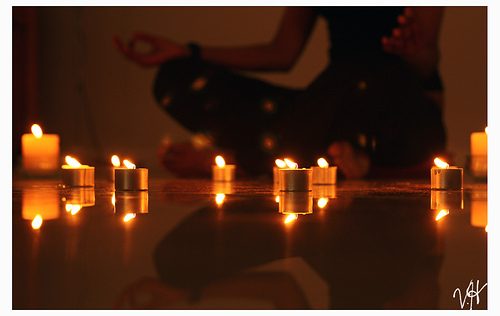
For years, when I complained about my anxious, racing mind and how my patience disappeared after having children, friends, acquaintances and mentors suggested meditation.
I tried, a smattering of times on my own, to sit silently and breathe. I didn’t know it at the time, but I had some preconceived notions about meditation that were stopping me before I could get started.
Finally, after realizing how much my hot, reactive temper was affecting my parenting, I signed up for an eight-week meditation course based on the teachings of meditation pioneer Jon Kabat-Zinn.
One by one, my meditation myths were stripped away.
1. I’m not good at it.
For the first few weeks of the course, as the teacher led us through longer and longer periods of meditation, I was convinced I sucked at mindfulness.
While my classmates all seemed to be achieving instant enlightenment—I could tell because I sometimes, illicitly, popped an eye open to peer at them sitting peacefully—my mind raced around like a methed-up squirrel. My arms itched, my legs twitched and I sneezed.
I thought perhaps I was actually allergic to meditation.
I assumed that my classmates were sitting around with minds as still and blank as a turned off TV, while my mind channel-surfed at high speed.
But one time after a session, the instructor asked people how it went.
“I really hate the body scan,” one student confessed. My eyes widened as several classmates nodded in agreement.
“I can’t concentrate at all,” another admitted.
When I realized that the human mind’s job is to think like a puppy that needs to be trained to slow down, I got it. That was the practice. Surfing my own breath with a blissfully still mind wasn’t the practice—it was noticing when my thoughts started to wander and coming back, over and over again. As our teacher wisely stated, “The moment you notice you’re not present, you become present.”
2. I don’t know how.
Along with thinking I stunk at meditation, I also believed that there was some magical, special way to meditate, and I wasn’t in on it. Surely, some secret mantra existed, or an exotic chant in a long-dead language, and I didn’t know it. I also didn’t know how to sit properly, where to place my restless hands, or whether to leave my eyes open or closed.
Our teacher guided us through several different ways of meditating, ranging from the well-loathed body scan to walking meditation. We tried gentle yoga postures and mindful eating (pro tip—don’t bring carrots for a mindful lunch unless you’re extremely un-self-conscious).
I learned that there’s no one right way to meditate. These days I pick my variety of meditation as if from a menu, choosing what I’m most in the mood for, or what my body seems to be craving.
When I’m feeling ultra-restless, I’ll do vinyasa yoga. If I’m feeling a little low, I might choose a loving-kindness meditation. My goal is no longer to “do it right,” but to just do it.
3. I don’t have time.
“I want you to try and practice at least 45 minutes of daily meditation or yoga for the duration of the course,” the teacher said on the first day of class.
I choked down a guffaw.
Didn’t she know I had two little kids? A part-time job? And a nighttime Netflix addiction that demanded feeding?
“You’ll have to really make it a priority and pay attention to your resistance,” she said in her calm, caramel-coated voice.
It felt like a dare.
So I juggled things around. I let my to-do list sit while I lay on the screen porch and twitched my way through the body scan. I fit in extra yoga classes on the weekends, and a few times, I even traded in my Netflix time for an evening meditation.
Inside, things started to shift. Sometimes, when one of my kids tossed a tantrum my way, I felt a cool space hover between their behavior and my reaction.
It was working.
I also learned that we don’t need an abundance of spare time to start a meditation practice. When I’m feeling ultra-resistant, I’ll set my timer for two minutes every morning while I sit quietly and count my breaths. Maybe I say a quick metta blessing for the people in front of me at the grocery store while I wait in line. Or maybe each time I see the red glow of a stoplight on the way to the grocery store, it’s my cue to take a few long, deep breaths.
While the more we meditate, the more benefit we may see, these small acts have value.
4. I don’t have a meditation room.
Somewhere in my mind, I thought that I needed a velvet-draped altar, strewn with incense and the toenail clippings of a violet-hued unicorn to properly meditate.
Through meditating at the class, in my bed and at yoga, I realized the only thing I literally need to meditate is myself.
Now, I usually sit in a corner of my bedroom next to a large pile of unwashed laundry. It’s not fancy, and it sometimes smells a little bit unsavory, but once I close my eyes, my surroundings disappear anyways.
Since taking the mindfulness course, I’ve continued to make meditation a daily practice. As each myth dissolved, I eased further into the calm that I’d been searching for.
More awesome from Lynn:
The 5 Stages of Queefing in Yoga Class. {Adult}
Relephant:
How to Meditate Every Damn Day. (No, seriously!)
Author: Lynn Shattuck
Editor: Renée Picard
Photo: Vinni/Flickr











Read 0 comments and reply